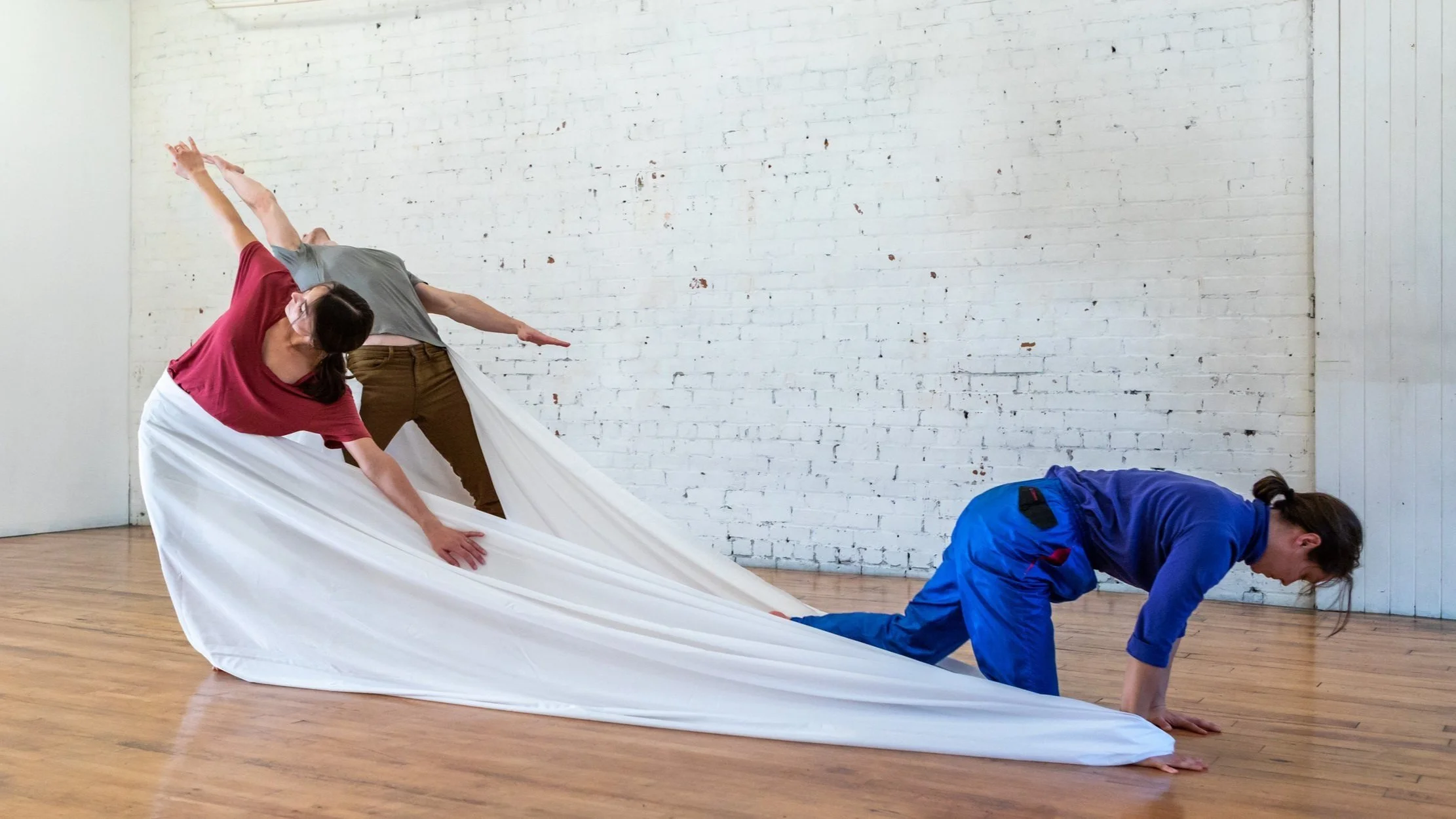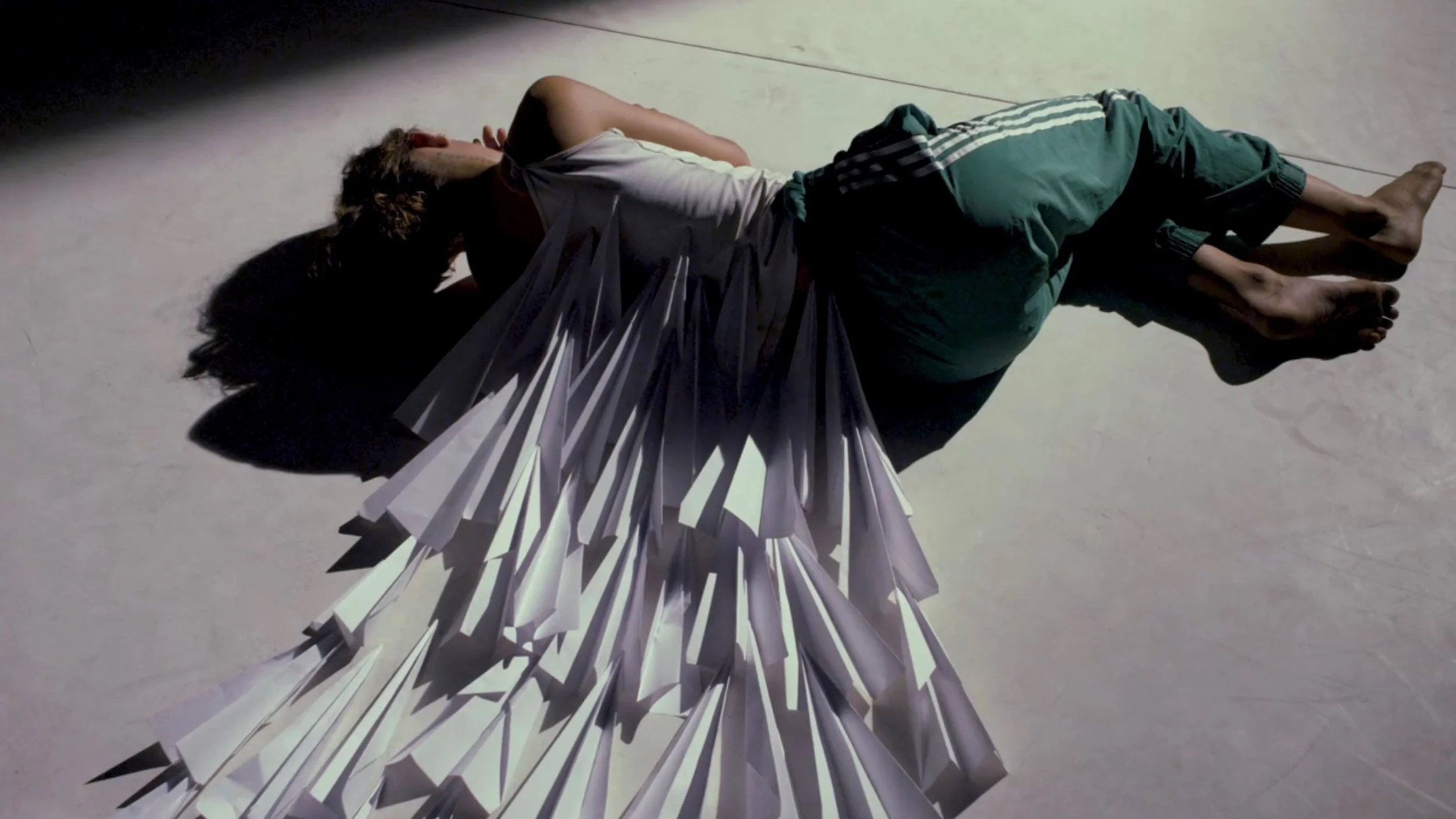Pandemic explorations, through paper planes and white fabric, at The Dance Centre's Open Stage #2
Emerging choreographers Anya Saugstad and Rachel Maddock explore space, memory, and isolation through vivid set pieces
Rachel Maddock’s Proximity. Photo by Andi McLeish
A still from Anya Saugstad’s Paper Mountains (of Memory). Photo by Brad Jorstad
The Dance Centre presents Open Stage #2 at the Scotiabank Dance Centre on April 3 at 7 pm
From masses of paper planes to armfuls of white fabric, two new works in the latest Open Stage program send set pieces into motion as much as the dancers.
This long-postponed, uncurated second edition of The Dance Centre series features short works by four different artists.
And in the case of choreographer Anya Saugstad, her filmed version of Paper Mountains (of Memory), to be screened amid the other live performances, has required uncountable hours of building little paper peaks and planes.
“I was experimenting with paper planes and paper because I like the way it overwhelmed the space—it seemed to completely cover a space without using a lot of budget,” Saugstad tells Stir. “It was a way to really change the environment around the dancers.
“Then, as we started to play with the paper planes, there were a lot of different ways to throw them,” she continues. “They were kind of like a moving body, in a sense, because they were able to move around the dancers. We even use a fan in this piece, at one point, to move the planes.”
Of course, crafting planes that could fly took a certain amount of effort. The dancers lent a hand early in the process, and Saugstad said it quickly became clear that dancer Sabine Raskin had the best technique.
“We’ve kept a lot of them through the different renditions—but not all of them, because if you want the plane to fly, it can't have a crumpled nose,” Saugstad shares, and then adds with a laugh: “So, yes, I have quite a few garbage bags of paper planes in my house.”
But the piece is really an exploration of loneliness, isolation, and memory. Saugstad, perhaps best known for her work dancing with Action at a Distance’s Vanessa Goodman, said it grew out of solo studies she created through the early part of the pandemic.
“I kind of had this sense that I needed to keep going, to keep my creative process going in some way,” she explains. “I had a studio and I said, ‘I’m just gonna keep dancing and keep making work on myself.’ I had no plans for it; it was just making it to keep experiencing the world through movement.”
Fortunately, Saugstad often video-taped that process. And it was looking at all that work after a year or so—a movement diary of memories—that she realized she could make something bigger out of the material, pulling in other dancers. Raskin, Daria Mikhaylyuk, Eowynn Enquist, Nasiv Sall, and Shion Skye Carter performed in the filmed version, with a haunting original score by Stefan Nazarevich.
Elsewhere on the Open Stage #2 program, Rachel Maddock’s Proximity also pulls inspiration directly from lockdown—and uses a striking set piece.
In her trio, performed by Maddock alongside Hana Rutka and Damian Kai Norman, she explores the use of a 30-foot swath of white poly-satin as a metaphor for all the social-distancing restrictions we faced over pandemic times—and the way they changed how we exist together in space.
“Space, and how we were organizing ourselves in space, felt really relevant to the pandemic,” she explains in a separate phone call. “It’s been so dictated in the past year and a half, the way we’ve been directed and have to stand apart and have different barriers. So that was very interesting to bring into the process.”
Maddock, an independent dance artist who graduated from SFU School for Contemporary Arts and who has performed for the likes of Deanna Peters’s Mutable Subject and plastic orchid factory, found that fabric could create a perfect structure for those explorations.
“I was interested in working with stage fabric—in how it makes space visible, and how you can delineate things,” she explains. “It becomes a co-performer and sort of an obstruction, physically.”
Maddock has explored myriad ways of playing light off the fabric.
“And it’s very visually interesting the way that fabric moves—the way that it moves with bodies and around bodies, and how we can move inside of it,” she says. “What I’m interested in is, ‘How can I create directionality with fabric on a larger-than-life sphere?’ It extends my reach in the space.”
You can find out what she’s talking about at the show Sunday night, alongside works by Linda Hayes and Lamondance. And maybe, amid the rippling fabric and soaring paper airplanes, you’ll get some clearer insight into your own experiences of the past two years as well.














